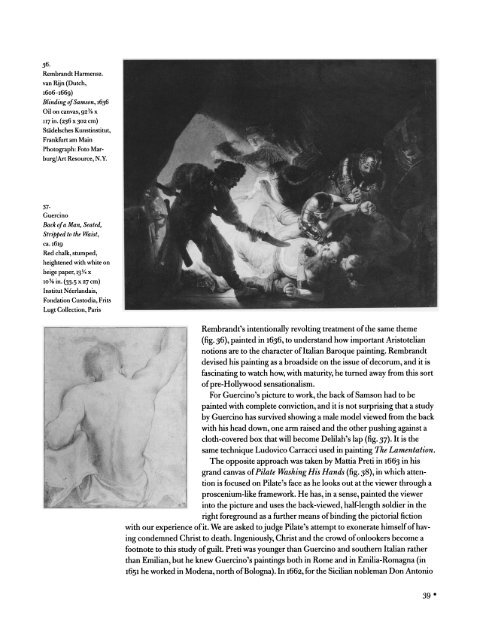GOING FOR BAROQUE Into the Bin - The Metropolitan Museum of Art
GOING FOR BAROQUE Into the Bin - The Metropolitan Museum of Art
GOING FOR BAROQUE Into the Bin - The Metropolitan Museum of Art
Create successful ePaper yourself
Turn your PDF publications into a flip-book with our unique Google optimized e-Paper software.
36.<br />
Rembrandt<br />
Harmensz.<br />
van Rijn (Dutch,<br />
1606-1669)<br />
Blinding <strong>of</strong> Samson, 1636<br />
Oil on canvas, 92%<br />
x<br />
117 m. (236 x302 cm)<br />
St?delsches Kunstinstitut,<br />
Frankfurt am Main<br />
Photograph:<br />
Foto Mar<br />
burg/<strong>Art</strong> Resource, N.Y.<br />
37<br />
Guercino<br />
Back <strong>of</strong> a Man, Seated,<br />
Stripped to <strong>the</strong> Waist,<br />
ca.1619<br />
Red chalk, stumped,<br />
heightened<br />
with white<br />
beige paper, 13 V* x<br />
10% in. x (33.5 27 cm)<br />
on<br />
Institut N?erlandais,<br />
Fondation Custodia, Frits<br />
Lugt Collection,<br />
Paris<br />
Rembrandt's<br />
intentionally revolting<br />
treatment <strong>of</strong> <strong>the</strong> same <strong>the</strong>me<br />
(fig. 36), painted<br />
in 1636, to understand how<br />
important Aristotelian<br />
notions are to <strong>the</strong> character <strong>of</strong> Italian<br />
.f<br />
Baroque painting.<br />
Rembrandt<br />
devised his as a painting<br />
broadside on <strong>the</strong> issue <strong>of</strong> decorum, and it is<br />
/<br />
fascinating<br />
to watch how, with maturity,<br />
he turned away from this sort<br />
/<br />
<strong>of</strong> pre-Hollywood<br />
sensationalism.<br />
For Guercino's picture<br />
to work, <strong>the</strong> back <strong>of</strong> Samson had to be<br />
I painted<br />
with complete conviction, and it is not<br />
surprising<br />
that a study<br />
by Guercino has survived a<br />
showing<br />
male model viewed from <strong>the</strong> back<br />
with his head down,<br />
one arm raised and <strong>the</strong> o<strong>the</strong>r<br />
a<br />
pushing against<br />
cloth-covered box that will become Delilah's lap (fig. 37).<br />
It is <strong>the</strong><br />
same<br />
technique<br />
Ludovico Carracci used in painting<br />
<strong>The</strong> Lamentation.<br />
<strong>The</strong> was<br />
opposite approach<br />
taken by<br />
Mattia Preti in 1663 in his<br />
canvas<br />
grand<br />
<strong>of</strong> Pilate<br />
Washing<br />
His Hands<br />
(fig. 38),<br />
in which atten<br />
tion is focused on Pilate's face as he looks out at <strong>the</strong> viewer<br />
a<br />
through<br />
proscenium-like<br />
framework. He has, in a sense, painted<br />
<strong>the</strong> viewer<br />
into <strong>the</strong> picture<br />
and uses <strong>the</strong> back-viewed, half-length<br />
soldier in <strong>the</strong><br />
as a<br />
right foreground<br />
fur<strong>the</strong>r means <strong>of</strong> binding<br />
<strong>the</strong> pictorial<br />
fiction<br />
with our<br />
experience<br />
<strong>of</strong> it. We are asked to judge<br />
Pilate's attempt<br />
to exonerate himself <strong>of</strong> hav<br />
ing condemned Christ to death. Ingeniously,<br />
Christ and <strong>the</strong> crowd <strong>of</strong> onlookers become a<br />
footnote to this study<br />
<strong>of</strong> guilt.<br />
Preti was<br />
younger than Guercino and sou<strong>the</strong>rn Italian ra<strong>the</strong>r<br />
than Emilian, but he knew Guercino's<br />
paintings<br />
both in Rome and in Emilia-Romagna (in<br />
1651 he worked in Modena, north <strong>of</strong> Bologna).<br />
In 1662, for <strong>the</strong> Sicilian nobleman Don Antonio<br />
39
















